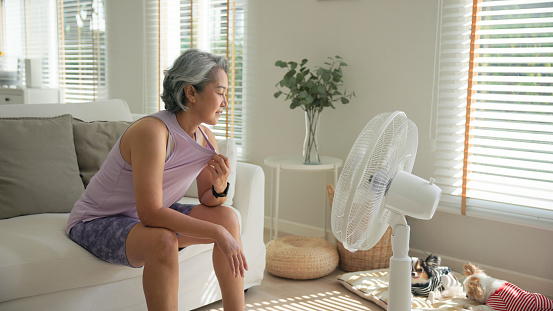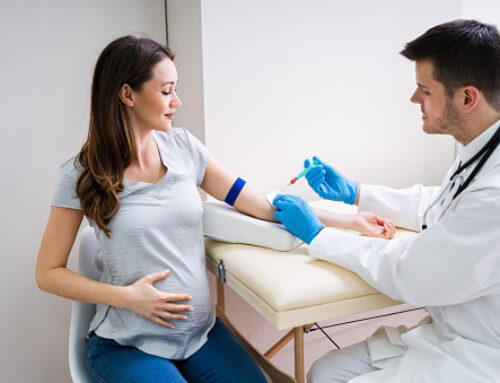Summer is hot enough – but if you begin to experience hot flashes during already high temperatures, it can make you miserable. Managing hot flashes in the summer is a whole new ball game, especially if your hot flashes become more frequent and intense when the weather is hot and humid outside.
Hot flashes can significantly disrupt your daily life and ability to sleep, cause feelings of anxiety to surge, and increase your risk for heart disease and other serious health concerns. The combination of summer heat and hot flashes often exacerbates these effects, making you even more uncomfortable.
Relief is on the way! TopLine MD Alliance and our trusted network of women’s health providers are here to guide you safely through perimenopause (the transitional period before menopause) and menopause with expert care and compassion. From managing hot flash symptoms more effectively to available medical and holistic treatments, your days of melting this summer may soon be over.
What are hot flashes, and why do they happen?
Hot flashes are the most common symptom of menopause, affecting up to 85% of women during the menopausal transition. However, not all women experience hot flashes to the same degree or for the same duration.
Some hot flashes are mild and brief (anywhere from a few seconds to a few minutes), while others are more intense and last longer. Hot flashes can occur multiple times a day, from a few times per week to several times per hour. They can also happen any time, even in the middle of the night, and usually come without warning.
A typical hot flash feels like a sudden burst of warmth or heat in your upper body (your face, neck, or chest). You may also experience the following at the same time:
- Sweating
- Red, blotchy skin
- Rapid heartbeat
- Heart palpitations
- Dizziness
- Chills and/or clammy skin after the hot flash passes
Hot flashes during perimenopause and menopause are primarily caused by hormonal changes, specifically declining estrogen levels, that disrupt how your body regulates temperature. These hormonal changes set off a cascade of events that lead to the sudden increase in body heat, sweating, and other symptoms associated with hot flashes.
While hormones are primarily to blame, other factors can trigger or worsen hot flashes, including:
- Feeling stressed or anxious
- Drinking caffeinated or alcoholic beverages
- Drinking hot beverages like coffee, tea, or hot chocolate
- Eating spicy foods
- Smoking cigarettes
- Being overweight
- Wearing tight or heavy clothing
- Taking hot showers or baths
Another big factor: hot weather and warm environments. And that’s where summer comes in!
Are hot flashes different during perimenopause and menopause?
Like the seasons, hot flashes during perimenopause and menopause can vary in frequency, intensity, and duration.
Perimenopausal hot flashes tend to be more erratic due to fluctuating hormone levels as your ovaries begin to produce less estrogen. Once you are in menopause, hot flashes may happen more often and become more intense as your body adjusts to the lower estrogen levels.
Why do hot flashes feel worse or more frequent during the summer?
Hot flashes usually feel worse during the summer due to increased sensitivity caused by these hormonal changes during perimenopause and menopause. The hot, humid weather during summer heightens this sensitivity even more, often causing more frequent and more intense hot flashes. If your body is already more prone to overheating, summer temperatures certainly don’t help!
Here are some other summer-specific issues that can make your hot flashes worse:
- More time outside – Most people spend more time outside in the summer. Warm weather environments like backyards, patios, pools, and beaches can exacerbate hot flashes. Add in too much sun exposure, and it’s even more likely your hot flashes will flare up.
- Summer social events – Summer social events like pool parties, barbecues, and holiday gatherings are likely to include caffeinated and alcoholic beverages, spicy foods, and other hot flash triggers.
- Travel stress – Are you taking a trip this summer? Travel can cause excess stress due to busy airports, missed flights, crowded highways, and other logistical issues.
- Lost medication – If you travel and take any form of menopause medication, always keep it with you. Luggage sometimes gets lost, and missing a dose of medication can worsen your hot flashes.
- Temperature changes – During the summer, we spend a lot of time going from hot, humid air outside to air conditioning inside. When a hot flash ends, some women get chills due to the sweat moistening and cooling their skin. A sudden blast of air conditioning might make you feel even colder. Keep a light sweater or wrap nearby, just in case.
What can you do at home to make your environment more comfortable?
You can’t control what’s happening outside your home, but you can make changes inside to help minimize hot flashes:
- Keep it cool – It’s hot out there! Keep your home, especially your bedroom, as cool and comfortable as possible. Adjust your thermostat, use fans, or open your windows – whatever helps prevent overheating. Even a handheld fan can provide quick cooling relief.
- Stay hydrated – Always keep cool water nearby, so you can take a sip at any time. The current recommendation for women is at least 11.5 cups of fluids per day. Remember to avoid caffeinated and alcoholic beverages, which can trigger hot flashes.
- Dress in layers – Wear clothing made with lightweight fabric that allows your skin to breathe, and dress in layers that can easily be removed when a hot flash starts.
- Relax – Relaxation techniques like yoga, meditation, and deep breathing can help you manage stress and reduce hot flashes.
- Don’t smoke – Not smoking also helps ease hot flashes and can lower your risk of serious health conditions like heart disease, stroke, and cancer.
When should you talk to a doctor about hot flashes, and what medical treatments are available?
Hot flashes may seem like an inevitable symptom of menopause that you just have to deal with, but there are medical and holistic treatments available that can help improve them. If you have frequent hot flashes that are disrupting your daily life, visit your TopLine MD Alliance Network provider to discuss your options.
If you are experiencing hot flashes before the age of 45, it’s especially important to consult with your provider, as this could be a sign of early menopause. There are several health concerns associated with early menopause, including heart disease, osteoporosis, fertility issues, and cognitive decline.
For many women, hot flashes go away slowly on their own without treatment. But if you require treatment, your TopLine MD Alliance Network provider can help.
Hormone therapy
Estrogen is the primary hormone used to ease hot flashes. The key is to find the smallest dose of estrogen that successfully manages your symptoms.
Women who have had their uterus removed via hysterectomy can take estrogen by itself. However, women who still have their uterus must usually take progesterone with estrogen to protect themselves against endometrial cancer (cancer of the uterine lining). For women who can’t take progesterone, taking bazedoxifene with estrogen may also prevent the higher risk of endometrial cancer that you can get from estrogen alone.
The length of time you use the treatment depends on how well hormone therapy works for you, weighed against these risks. Ask your TopLine MD Alliance Network provider to learn more.
Antidepressants
The U.S. Food and Drug Administration (FDA) has approved only one treatment for hot flashes that does not use hormones – a low-dose antidepressant called paroxetine (Brisdelle).
Other antidepressants used to treat hot flashes include:
- Venlafaxine (Effexor Xr)
- Paroxetine (Paxil)
- Escitalopram (Lexapro)
- Citalopram (Celexa)
Antidepressants typically do not work as well as hormone therapy for severe hot flashes. However, they can help women who are unable to use hormones for treatment.
Other prescription medications
Other prescription medications that might provide relief from hot flashes include:
- Antiseizure medications like gabapentin (Neurontin/Gralise) and pregabalin (Lyrica)
- Oxybutynin (Oxytrol), a pill or patch used to treat an overactive bladder and other urinary conditions
- Clonidine (Catapres-TTS 1/Nexiclon Xr), a pill or patch used to treat high blood pressure
- Fezolinetant (Veozah), a daily pill that manages body temperature and hot flashes without hormones
Holistic treatments
The following holistic treatments for hot flashes do not require a prescription, but we still recommend consulting with your TopLine MD Alliance Network provider before taking them.
- Soy (plant estrogen)
- Black cohosh
- Evening primrose oil
- Vitamin E
- Acupuncture
Find a TopLine MD Alliance Network provider today
The TopLine MD Alliance was created by physicians who came together to make healthcare experiences better for patients. We help patients navigate the healthcare system, connecting them with top-of-the-line healthcare providers, practices, diagnostic centers, and imaging centers we trust.
Our women’s health specialties include gynecology, urogynecology, gynecologic oncology, female pelvic medicine and reconstructive surgery, and many more. To find a provider near you, visit us online today.
The TopLine MD Alliance is an association of independent physicians and medical practice groups who are committed to providing a higher standard of healthcare services. The members of the TopLine MD Alliance have no legal or financial relationship with one another. The TopLine MD Alliance brand has no formal corporate, financial or legal ties to any of the physicians or practice groups in the network.




